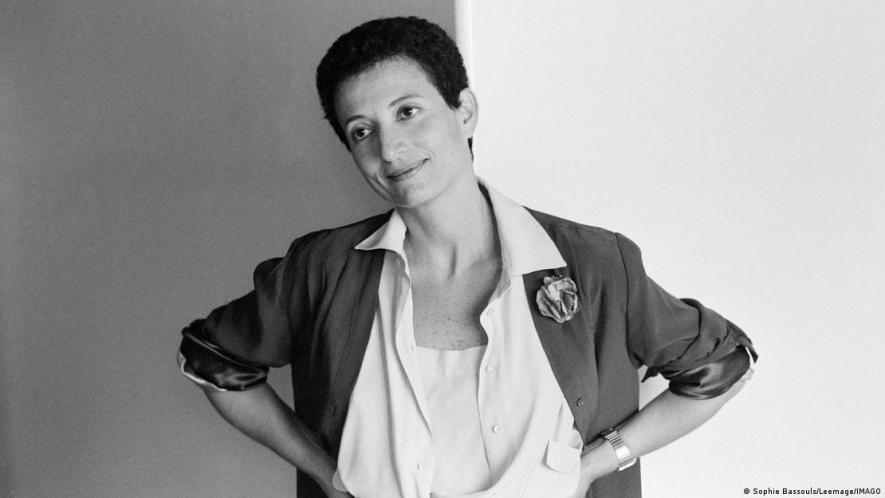Women Protesting in Iran Symbolize Desire for Freedom

The writer, theorist and feminist Helene Cixous was born in Algeria in 1937 and has long lived in Paris. She came to public renown for her essay, "The Laughter of Medusa" (1975), in which she outlines how women can defend themselves against widespread oppression.
Speaking to DW from Paris, Cixous says that the current women-led protests in Iran are part of an extended feminist movement in the country.
Deutsche Welle: The current protests in Iran were sparked when 22-year-old Jina Mahsa Amini died in custody after she was arrested by morality police. What is the situation for women in Iran and how are they driving the protests?
Helene Cixous: Almost since the beginning of the Western feminist movements in the 1970s, Iranian women have symbolized resistance to alienation and the desire for freedom. There has been revolution after revolution in Iran for a hundred years. In every protest movement, women have been the victims and at the forefront.
Iranian women are real role models and are very educated. In 1979, they were the symbols of charity, solidarity and compassion. They were the ones who demonstrated in the streets. Then came the first act of repression: Women had to cover themselves with the veil.

A protester holds a portrait of Mahsa Amini during a demonstration in Turkey in September following her death
Who would have thought that this veil would become the symbol of women's struggle against oppression for all time? The latest episode was the match thrown on the powder keg.
My Iranian women friends tell me about their double life. On the street, they disguise themselves. At home, they are free and escape the hostility of this dictatorship. It is not surprising that this woman [Mahsa Amini] became such a symbol. Great liberation wars and movements are often triggered by just one incident.
Your best-known work is the essay "The Laughter of Medusa". In it, you describe, among other things, how women should oppose patriarchal systems of oppression. How have these ideas manifested in the Iranian protests?
My text was an update of Greek mythology. There is no better example to describe the position of women and the murderous battle men take up against women. Medusa was one of three Gorgons [powerful, winged daemons], the daughters of Phorkys and Keto.
She was the only mortal among them. Men were afraid of her. When they looked at her, they turned to stone. But why did she have such great power over men? Because she saw the men. The latter did not have the time to see her.
Men do not want to see women and they put veils over them so that they become invisible, like phantoms. It is terrible to what extent women have been veiled, even in daily life. Yet women are not objects, not veiled dolls. They are radiant. They are beautiful. My Medusa has traveled around the world. Right now she is obviously in Iran.

Helene Cixous was born into a Jewish family in Algeria in 1937. She relocated to Paris in 1971 and is pictured here in 1983.
Some say that if the headscarf ban falls in Iran, the regime will fall. Do you see it that way too?
The two would go hand in hand. The veil stands for tyranny. By the way, none of my Iranian friends believe that the announcement that the morality police will be abolished will improve the situation in any way. A woman who tears her veil off her head in the street, as Iranian women do, is incredibly brave. She has conquered the fear of death.
But this strong gesture does not mean victory. Because the woman has to put the veil back on when she goes into a public building. The regime shows incredible cruelty. It recently killed two young people in such a horrible way. The government is prepared to torture. It wants to burn this into the memory of Iranians, especially young people and women. They bury women alive and say we will tear your heart out.
How can a regime exist that is based on cruelty to women?
Only the regime itself knows. But I don't think humans are capable of such things, only brutes. Even if such things do not only happen in Iran.
Where do Iranian women get all this courage?
Only the Iranian women themselves can tell you that. But I am deeply impressed by their courage. And of course, I ask myself whether I can legitimately comment on this. After all, I'm not in Iran and I'm not risking my life like the people there. But my Iranian friends told me, why don't you do something? Speak! If you speak, the local people will hear. It is important for me to say, I heard you.
Is the veil for you a symbol of repression, under any circumstance?
Yes. It is meant to make women vanish, to exclude them. Some say, there is a "good" veil. In France, some women see it as a political gesture, because the secular country is against women wearing the veil and thus the veil is, for these women, a war cry against the government. But why don't these women talk about the situation of their contemporaries in Iran? Don't they see that in a country with a such a long tradition, the veil restricts life, the body, freedom, and hope?
How do you see the near future in Iran?
I don't know. Even the people of Iran don't know. What is happening at the moment is impressive but also very fragile. All these demonstrations of revolt, of pride, of dignity — it's like a volcano with extraordinary power. But this volcano needs to be fuelled. Who is doing that? Ukraine is being helped by the West, and that is a good thing. But who will help the Iranians once all the demonstrators are in prison or executed?
This article was originally written in German.
Get the latest reports & analysis with people's perspective on Protests, movements & deep analytical videos, discussions of the current affairs in your Telegram app. Subscribe to NewsClick's Telegram channel & get Real-Time updates on stories, as they get published on our website.
























